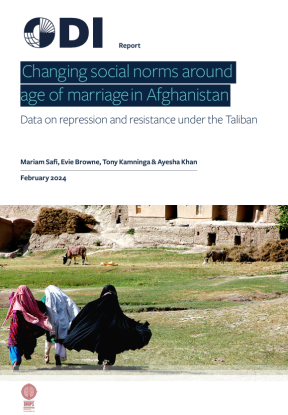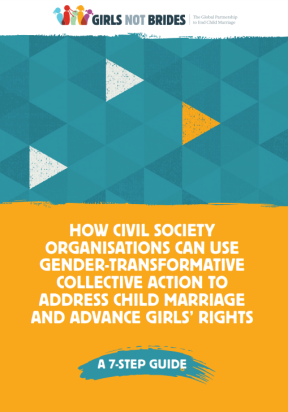
- Toolkit
- 15 April 2019
Programming and multi-media resources on norms and child marriage
- Author: Margaret E. Greene , Ellen Stiefvater
- Published by: ALIGN
Programming resources
As donor and practitioner interest in social norms is relatively recent, many implementers currently struggle with questions around operationalisation. Given conflicting views on the usefulness of social norms-related programming, and how to ‘do it right’, what is the best guidance for implementers?
For a list of useful resources on research tools to help in understanding social and gender norms influencing child marriage, visit the ALIGN platform child marriage tools list.
Some recent materials from programmes with norm-change activities include:
- CARE’s Tipping Point programme. This uses specific social norms-related design principles, linking activities to those design principles. A key part of the approach is to help people envision positive alternatives: such as cooking competitions for boys in Nepal, or organised football for girls. The research also includes documenting people’s reactions to the activities. Social norms innovations briefs.
- DREAMS initiative. The DREAMS Core package of interventions include a number of programmes which aim to reduce girls’ risk of HIV. These include programmes aimed at supporting positive relationships between girls and their parents or caregivers, cash transfers for families, education subsidies to keep girls in school, social and financial empowerment programmes, school-based sex education, interventions to build girls’ social skills and social networks, and ‘community mobilisation’ designed to ‘engage boys, men, and the broader community in addressing social norms that increase HIV risk for adolescent girls and young women’.
- Girls not Brides published a number of briefs in 2017 describing different programmes’ experiences in designing interventions aimed at normative change. In January 2018, they organised a webinar that brought different resources together, and highlighted effective strategies and approaches that do not work. Among the effective strategies identified were the need to know the context, rely on local leadership, help communities make the links between their values and child marriage, focus on positive norms in the community, and work with early adopters or ‘positive deviants’ who can come together to become champions. Approaches that do not work include shaming, single-dimension programmes that focus on one population group only, and the expectation that change can happen every quickly.
- An evaluation of the Teenage Mothers Project in Uganda using semi-structured interviews, life histories and analysis of sociodemographic characteristics found that the project contributed to the well-being of the target population of unmarried teen girls by contributing to supportive community norms and improved coping with teen motherhood. The intervention used a socio-ecological approach which included community participatory planning (Leerlooijer, 2013).
- World Vision and Promundo (2013). A more equal future: a MenCare manual to engage fathers to prevent child marriage in India. This facilitators’ manual was developed by World Vision and Promundo as a response to strong social norms that support the continuation of child marriage. It provides step-by-step instructions and content ideas for the facilitation of men’s groups, with the aim of creating safe and constructive space for men to reflect on and redefine what it means to be men and fathers in their communities. Session themes focus on areas where social norms support the devaluation of girls and limit men’s participation in domestic and care work, such as ‘gender roles in society’ and ‘power and early marriage’ (World Vision and Promundo, 2013).
- The Passages Project, run by Georgetown University’s Institute for Reproductive Health, aims to test and scale up interventions that ‘promote collective change and foster an enabling environment for healthy timing and spacing of pregnancies and family planning’ by addressing a range of social norms (IRH, n.d.).
- The Tostan community Empowerment Program (Tostan, n.d.) is one of the best-known programmes working to reduce child marriage. Developed in rural Senegal, the Tostan approach uses human-rights-based non-formal education. Women and girls went through a three-year curriculum learning to apply human rights to their own contexts and to challenge harmful traditional practices, and other community members and village leaders were later brought into the conversation and encouraged to leverage their own networks to raise awareness. The programme was instrumental in thousands of villages making public declarations to end child marriage. Tostan’s Child Protection Module provides training to Community Management Committees to address the social norms and practices that harm children, including child marriage.
Multimedia resources on gender and social norm change and child marriage
- In early 2018, Girls Not Brides organised a webinar to look at the current state of knowledge on social norms and child marriage (Girls Not Brides, 2018).
- The Council on Foreign Relations created an InfoGuide (CFR, n.d.) to complement their 2013 report Ending child marriage: How elevating the status of girls advances U.S. foreign policy objectives (Vogelstein, 2013). It provides a useful overview on the geography, drivers and policy implications of child marriage. With a focus on its deep and lasting development implications, CFR has made an effort to elevate child marriage to a US government foreign policy priority, and helps to combat the perception that it is a ‘soft issue’ in foreign policy terms.
- Overseas Development Institute (ODI) podcast: ‘Transforming the world for girls’ (ODI, 2017). This three-part podcast series explores ODI’s four years of research on transforming the lives of adolescent girls, which focused on norms related to education and child marriage.
- Economic Impacts of Child Marriage Webinar: Organised by Girls Not Brides, this webinar shared information about new research on the economic impacts of child marriage carried out by the International Center for Research on Women (ICRW) and the World Bank (Girls Not Brides, 2016).
- Overseas Development Institute intergenerational interviews (ODI, 2015): Gender discrimination and early marriage: three generations of women in Nepal.
- Oxfam webinar on social norms relating to child marriage (Youth Active Citizens) (Oxfam, 2017).
- STRIVE channel: webinar on the influence of social norms on intimate partner violence and HIV (with a focus on child marriage) (STRIVE, 2017).
- Harvard School of Public Health and Jacqueline Bhabha, webcast on child marriage (as it relates to child mortality) (Harvard School of Public Health, 2013)
Films on child marriage
The Girls Not Brides website features an array of documentary and feature films about child marriage. In many cases the filmmakers intended to raise awareness of the impacts of the practice on individual girls and their families; this type of advocacy aims to question prevailing norms by increasing transparency about their consequences. It often does so by highlighting other norms, which are perhaps violated by the practice, such as norms around the protection of children. Film and photography can be powerful tools for raising awareness and galvanising resources among donors. Below are a few examples (see www.girlsnotbrides.org for a more complete listing):
- DIFRET is an Ethiopian feature film based on a true story about a 14-year-old girl who is abducted for marriage, according to village tradition, and ends up killing her intended husband in the struggle. The plot focuses on the legal fight that ensues, and portrays the tension between tradition and transformation in Ethiopia through the lives of the girl and her female lawyer.
- Dukhtar is a 2014 Pakistani feature film about a mother and daughter fleeing the girls’ impending marriage to a tribal elder. The film unfolds as a suspenseful story as the women are pursued through the countryside. Reviews praise the cinematography and portrayal of the mother-daughter relationship; misogynistic norms are the backdrop.
- Child Mother is a 2016 documentary film centring on conversations between women and their children about their experiences of being forced into marriage as children. The women featured are from Jewish communities in Yemen and Morocco, and the stories of their marriages had often been kept from their own children. Their stories reveal the trauma suffered by the women, as well as the enormous impact of that trauma on their own children and family life.
- Tags:
- Child marriage
- Countries / Regions:
- Global
Related resources
Report
22 February 2024

Toolkit
16 May 2023

Report
3 March 2023
